Gobihadros
Gobihadros is a genus of basal hadrosauroid dinosaur that lived in Asia during the Late Cretaceous period. It contains one species, Gobihadros mongoliensis. The holotype specimen was recovered from the Bayan Shireh Formation (Cenomanian-Santonian). It has an estimated length of 7.5 m (25 ft).
| Gobihadros | |
|---|---|
| Skull of specimen MPC-D100/763 | |
| Scientific classification | |
| Kingdom: | Animalia |
| Phylum: | Chordata |
| Clade: | Dinosauria |
| Order: | †Ornithischia |
| Suborder: | †Ornithopoda |
| Clade: | †Hadrosauromorpha |
| Genus: | †Gobihadros Tsogtbaatar et al., 2019 |
| Type species | |
| †Gobihadros mongoliensis Tsogtbaatar et al., 2019 | |
Discovery and naming
Between 1993 and 2004, the Mongolian Palaeontological Center and the Japanese Hayashibara Museum of Natural Sciences excavated sites at Bayshin Tsav. Material was discovered of a basal hadrosauroid new to science. Tsogtbaatar treated this species in his dissertation of 2008.[1]
In 2019, the type species Gobihadros mongoliensis was named and described by Khishigjav Tsogtbaatar, David Bruce Weishampel, David Christopher Evans and Mahito Watabe. The generic name combines references to the Gobi Desert and the Hadrosauroidea. The specific name refers to the provenance from Mongolia. Because the describing article appeared in an electronic publication, Life Science Identifiers were needed to make the name valid. These were 38EE8AD7-AD50-44BF-B31D-B2675456556A for the genus and 2DB42EE7-6A64-4D64-AA19-E5D3453BF99C for the species.[1]
The holotype, MPC-D100/746, was found in a layer of the Bayan Shireh Formation dating from the Cenomanian-Santonian, roughly 85 million years old. It consists of a nearly complete skeleton with skull. While the postcranial skeleton was articulated, the skull was partly disintegrated. Numerous specimens have been referred to the species, the most important among them specimen MPC-D100/763, a complete articulated skull, with a hand. The specimens have partly been found in other sites in Mongolia. Combined, they make Gobihadros the most completely known basal hadrosauroid from Asia.[1]
Description

Gobihadros was a medium sized hadrosauroid. The specimen MPC-D100/763, was approximately 3 m (9.8 ft) at the time of its death, it was however, an immature individual. Other specimens reached larger sizes; MPC-D100/744 has a 72.8 cm (728 mm) long femur, indicating a length of 5.3 m (17 ft). Nevertheless, specimen ZPAL MgD-III/3 reached 7.5 m (25 ft) long, as indicated by its femur measuring 104 cm (1,040 mm). This size appears to be the top length in fully grown individuals, as indicated by the advanced age of ZPAL MgD-III/3, which features areas of bone resorption and bone remodeling on the femur and tibia.[1][2]
The describing authors indicated some distinguishing traits. Gobihadros differs from all known other non-hadrosaurid hadrosauroids in possessing a double-layered tomial edge of the premaxilla and the presence of as much as three teeth per tooth position in the lower jaw. These are typical hadrosaurid traits and were concluded to have been acquired separately by the Hadrosauridae in a process of parallel evolution. Gobihadros differs from Bactrosaurus johnsoni, Probactrosaurus gobiensis, Eolambia caroljonesa, Claosaurus agilis and Tethyshadros insularis by an undulating upper profile of the ilium and a more sidewards projecting supra-acetabular crest. Gobihadros differs from T. insularis, Plesiohadros djadokhtaensis and the Hadrosauridae in possessing a conical spike-like claw of the first finger.[1]
Classification
Gobihadros was placed in the Hadrosauroidea in 2019, in a basal position outside of the Hadrosauridae. Its exact affinities were unclear as it was recovered in a polytomy with many other such forms. Its existence was seen as affirming a pattern of subsequent American hadrosauroid invasions into Asia.[1]
References
- Khishigjav Tsogtbaatar; David B. Weishampel; David C. Evans; Mahito Watabe (2019). "A new hadrosauroid (Dinosauria: Ornithopoda) from the Late Cretaceous Baynshire Formation of the Gobi Desert (Mongolia)". PLoS ONE. 14 (4): e0208480. Bibcode:2019PLoSO..1408480T. doi:10.1371/journal.pone.0208480. PMC 6469754. PMID 30995236.
- Slowiak, J.; Szczygielski, T.; Ginter, M.; Fostowicz-Frelik, L. (2020). "Uninterrupted growth in a non‐polar hadrosaur explains the gigantism among duck‐billed dinosaurs". Paleontology. doi:10.1111/pala.12473.

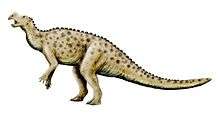

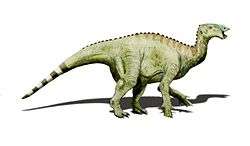
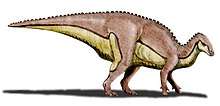
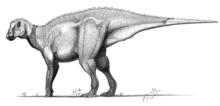
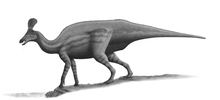
.jpg)